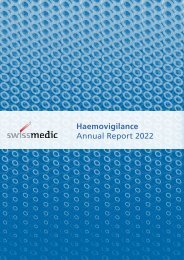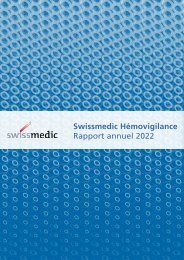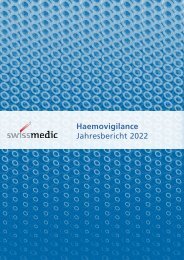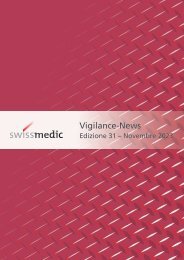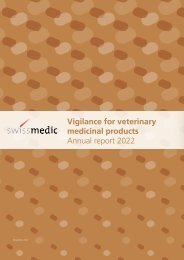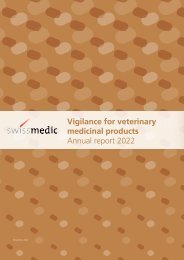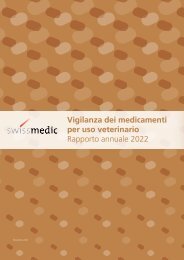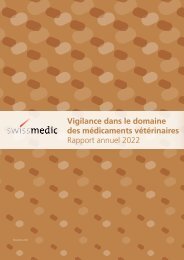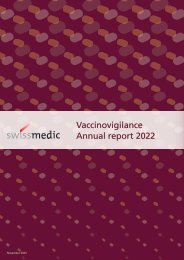Swissmedic Vigilance News Edition 20 – June 2018
Special issue: The history and development of pharma-covigilance in Switzerland over the last three decades
Special issue: The history and development of pharma-covigilance in Switzerland over the last three decades
Create successful ePaper yourself
Turn your PDF publications into a flip-book with our unique Google optimized e-Paper software.
• Advances in the ultrasound monitoring of<br />
pregnancy may have raised expectations<br />
that malformations can be reliably detected<br />
and that this known risk of the<br />
substance is therefore "under control".<br />
This probably lowered the inhibition<br />
threshold for using valproate in pregnancy.<br />
• Prescribing practice has been slow to respond<br />
to the development of new antiepileptic<br />
agents. Whereas the available<br />
alternatives such as phenytoin and carbamazepine<br />
were also associated with<br />
teratogenic risks back in the early 1990s<br />
(albeit to a lesser extent than valproate),<br />
these were followed by the arrival on the<br />
market of new drugs that were considered<br />
to be less harmful and, still later, also<br />
much safer in respect of neurological developmental<br />
disorders.<br />
• Antiepileptic drugs very often constitute<br />
a long-term treatment. Possible problems<br />
in the event of a future pregnancy should<br />
be considered and addressed even when<br />
they are prescribed to adolescents. Wherever<br />
possible, exposure in pregnancy<br />
should be avoided and the treatment<br />
switched beforehand.<br />
the drug long before this is confirmed by<br />
epidemiological results.<br />
• Prescribing practice in this context is crucial.<br />
This should be taken into account<br />
and followed up as part of the risk management<br />
plan.<br />
• Established prescribing habits are difficult<br />
to change. Agencies such as professional<br />
associations, universities, patient organisations<br />
and cantonal authorities are important<br />
players in achieving a successful<br />
outcome. According to a study in the EU,<br />
the repeated tightening of restrictions in<br />
the case of valproate <strong>–</strong> warnings in the<br />
product information, DHPC, instruction<br />
materials, acknowledgement form for patients,<br />
subsequently supplemented by a<br />
patient card and pictogram on the pack <strong>–</strong><br />
failed to work as hoped. We have isolated<br />
examples of this in Switzerland as well. To<br />
prevent unplanned pregnancies occurring<br />
under treatment with valproate effectively<br />
and across the board, requires a<br />
comprehensive programme that is comparable<br />
with the one implemented for<br />
oral retinoids for the treatment of acne<br />
and that involves physicians, pharmacists<br />
and patients.<br />
Lessons for the future<br />
• The more surprising and serious an ADR<br />
is, the more attention it merits, particularly<br />
if the causality is initially called into<br />
question, which is often the case with unusual<br />
risks.<br />
• In retrospect, as regards developmental<br />
disorders and valproate, more attention<br />
should have been paid to one aspect that<br />
should always be noted in spontaneous<br />
reporting: developmental disorders associated<br />
with valproate often involve characteristic<br />
signs of dysmorphia, particularly<br />
of the face. Such a specific pattern is a<br />
strong indication of a causative role of<br />
<strong>Swissmedic</strong> <strong>Vigilance</strong> <strong>News</strong> | <strong>Edition</strong> <strong>20</strong> <strong>–</strong> <strong>June</strong> <strong>20</strong>18 9 | 14




